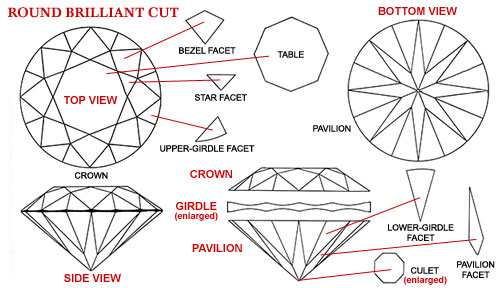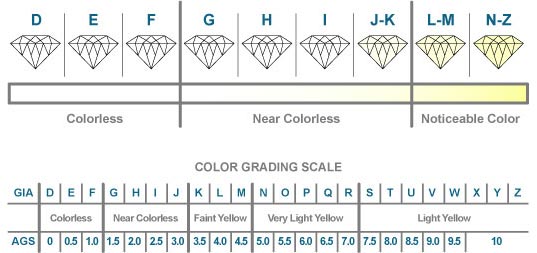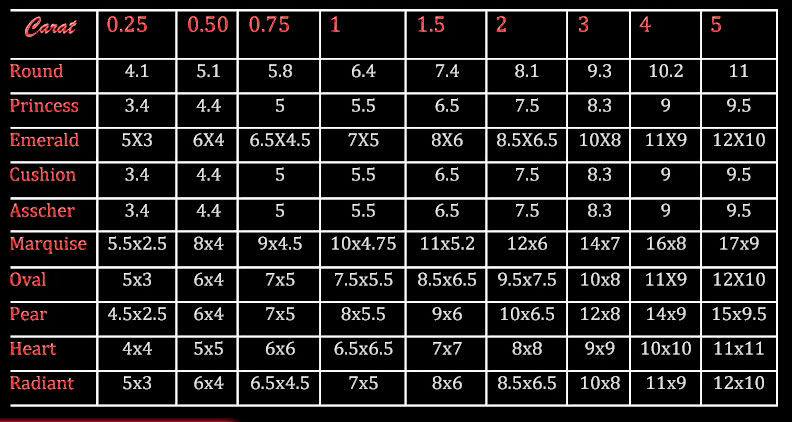
DIAMONDS EDUCATION
This Diamond Education defines the most essential characteristics of a diamond along with tips for its care. By understanding these characteristics, you will be able to shop with confidence.
MODERN STYLE
At Melisende Diamonds Ltd., we apply the same high quality standards to all of our diamond shapes. We have an exceptional collection of traditional round diamonds and we also offer the finest non-round or fancy-shaped diamonds available. All of our certified diamonds are graded by the GIA or AGSL to have FL-SI2 clarity, D-J colour, and Ideal, Very Good, or Good cut.
Our Signature Diamonds are the finest quality diamonds available on the market, and we offer them in round, princess-cut, Asscher-cut, and emerald-cut shapes. Choose your diamond shape since all diamond shapes are very different, unique characteristics determine quality for each shape. Select your shape below to learn how to recognise the most beautiful diamond. If you have additional questions, feel free to contact us.
Diamond cut is perhaps the most important of the 4C’s, so it is important to understand how this quality affects the properties and values of a diamond. A good cut gives a diamond its brilliance, which is that brightness that seems to come from the very heart of a diamond. The angles and finish of any diamond are what determine its ability to handle light, which leads to brilliance.When a diamond is well-cut, light enters through the table and travels to the pavilion where it reflects from one side to the other before reflecting back out of the diamond through the table and to the observer’s eye.
In a poorly cut diamond, the light that enters through the table reaches the facets and the ‘leaks’ out from the sides or bottom of the diamond rather than reflecting back to the eye. Less light reflected back to the eye means less brilliance.
Because cut is so important, several grading methods have been developed to help consumers determine the cut of a particular diamond. In general, these grades are:
Ideal cut: This cut is intended to maximize brilliance,
it applies only to round diamonds.
Premium cut: They are intended to provide maximum brilliance, Premium Cut diamonds have cuts that are the equal of any Ideal Cut diamond
Very Good cut: These diamonds reflect most of the light that enters them, creating a good deal of brilliance. With these diamonds, the cutters have chosen to stray slightly from the preferred diamond proportions in order to create a larger diamond.
Good cut: Diamonds that reflect much of the light that enters them. Their proportions fall outside of the preferred range because the cutter has chosen to create the largest possible diamond
Fair & Poor Cut: A diamond graded as fair or poor reflects only a small proportion of the light that enters it. Typically these diamonds have been cut to maximize the carat weight over most other considerations.
Diamonds are found in all colors of the rainbow, from colorless and transparent stones to ink black ones. Varying degrees of yellow or brown color is common in most of the diamonds and slight difference in color can make a substantial difference in value. A truly colorless diamond is extremely rare and considered the most valuable. It allows most light to pass through the stone and create the most brilliance. Most diamonds appear white to the naked eye, but they all include trace amounts of yellow or brown color. The best way to see the true color of a diamond is by looking at it against a white surface.
Fancy Colored Diamonds although majority of diamonds come in shades of white, there are also Fancy natural intensely colored diamonds available in colors like yellow, pink greens, brown, red, orange, blue etc. These intensely colored diamonds are very rare, attractive and desirable.
F: Flawless: No internal or external flaws. Extremely rare.
IF: Internally flawless: no internal flaws, but some surface flaws. Very rare.
VVS1-VVS2: Very Very Slightly Included. Minute inclusions very difficult to detect under 10x magnification by a trained gemologist.
VS1-VS2: Very Slightly Included. Minute inclusions seen only with difficulty under 10x magnification.
SI1-SI2: Slightly Included. Minute inclusions are visible under 10x magnification, and may be visible by the unaided eye.
I1-I2-I3: Inclusions visible under 10x magnification as well as to the human eye.

Clarity is a term used to describe the absence or presence of flaws inside or on the surface of a diamond. In other words, the clarity of a diamond refers to a diamond clearness or purity. When these flaws/marks occur internally, they are called inclusions and the most common types of inclusions include Crystals, Tiny Bubbles representing small minerals that were absorbed into the diamond while it was growing, Internal Graining, Needles, Knots, Chips, Cavities, Cleavage, Feathers, and Clouds. On the contrary, when these flaws/marks occur on the surface, they are known as blemishes and the most common types of blemishes include Polish lines, Naturals, Scratches, Nicks, Pits, transparent stress lines that appear on a diamond surface, surface graining, and extra facets, that are usually cut to remove a near-surface inclusion to raise the clarity grade of a stone. Most diamonds have these imperfections in them. Although many of these flaws are not visible to the naked eye, but under magnification, tiny featherlike shapes, crystals, bubbles and dark flecks become noticeable. These slight flaws make every diamond quite unique but they also do affect the beauty and value of th diamond. Diamond clarity is based on the number, size, nature, and location of imperfections on the finished stone. Diamond with higher clarity is more valuable in comparison to diamond that contains numerous inclusions because it is less brilliant due to inclusions interfering with light passing through it.
Key Points : Carat is specifically a measure of a diamond weight, and by itself may not accurately reflect a diamond size. We tend to evaluate diamond size by viewing it from the top because that is how diamonds are presented to us when set into a ring.
To understand diamond size, carat weight should be considered in conjunction with two other criteria: Distance in millimeters across the top of the diamond. Diamond cut grade. As the name suggests, carat weight specifically refers to a diamond weight. However, much as a person weight does not necessarily correlate with height, carat weight, by itself, may not accurately reflect a diamond size. To gain a precise understanding of diamond size,melisendediamonds recommends considering carat weight with two other characteristics:
1) the distance across the top of the diamond measured in millimeters
2) the diamond cut grade.
It is important to measure the distance across the top of the diamond as this is how we view a stone when set into a ring. A diamond cut grade should also be considered because, as we noted in the cut grade section, when a diamond is cut with the proper proportions, the maximum amount of light is returned out of the top of the diamond. Thus, when a diamond is well cut, the light reflected out of the top makes it appear larger. In addition, much of the weight of a poorly cut diamond, for example, may be hidden in the base of the diamond, making the diamond appear smaller than its carat weight would imply.It is therefore possible to have a diamond of a lower carat weight, but higher cut grade, that appears larger than a diamond with a larger carat weight, but poor cut. Once you have selected your cut, color, and clarity grade, it is easy to determine the carat weight of diamond that will fit within your budget. Much as there are 100 pennies in a dollar, a one-carat diamond is comprised of 100 points. Hence, 50 points is equal to 1/2-carat, and so on. This chart illustrates how diamonds of different carat weights look when set in a ring. Note that a 2-carat diamond does not appear to be twice the size of a 1-carat diamond when viewed from the top.
At Melisende Diamonds Ltd., we apply the same high quality standards to all of our diamond shapes. We have an exceptional collection of traditional round diamonds and we also offer the finest non-round, or fancy-shaped, diamonds available. All of our certified diamonds are graded by the GIA or AGSL to have FL-SI2 clarity, D-J colour, and Ideal, Very Good, or Good cut.
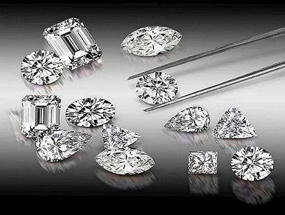
Our Signature Diamonds are the finest quality diamonds available, and we offer them in round, princess-cut, Asscher-cut, and emerald-cut shapes.Choose Your Diamond Shape Since all diamond shapes are very different, unique characteristics determine quality for each shape. Select your shape below to learn how to recognise the most beautiful diamond. If you have additional questions, feel free to contact us.
BROWSE BY SHAPE SECTION BELOW:
ROUND

The round brilliant cut diamond is by far the most popular and most researched diamond shape available today. For almost 100 years, diamond cutters have been using advanced theories of light behaviour and precise mathematical calculations to optimise the fire and brilliance in a round diamond. In addition to being the most popular and researched shape, a round diamond will typically give you more flexibility in terms of balancing cut, colour, and clarity grades while still getting the fire and brilliance you want.
To maximise the brilliance of a traditional round diamond, select one in the two highest cut grades, ideal or very good, and choose ideal, excellent, or very good polish and symmetry grades. For the finest ideal round diamonds available.PRINCESS

The princess cut is the most popular non-round diamond. It’s beautiful brilliance and unique cut makes it a favourite for engagement rings. The princess has pointed corners and is traditionally square in shape. When choosing a colour grade, consider that while the price of a J-colour non-round diamond is exceptional, colour may be slightly visible in its corners. Also, princess-cut diamonds can vary greatly in how square or rectangular they are. To find the dimension of princess you want, look for the length-to-width ratio in our interactive diamond search and on each diamond detail page. This will determine what the diamond will look like when viewing it from above. Here are length-to-width ratios for princess-cut diamond shapes that are pleasing to the eye. For a princess diamond shape that is square, look for length-to-width ratios between 1 and 1.05. If you prefer more of a rectangular shape, look for length-to-width ratios greater than 1.10. for the most brilliant princess available.EMERLAD

What makes the emerald cut different is its pavilion, which is cut with rectangular facets to create a unique optical appearance. Due to its larger, open table, this shape highlights the clarity of a diamond. If you choose an emerald-cut with a lower clarity grade, such as SI, be sure to review the clarity plot on the diamond certificate. Also, emerald-cut diamonds can vary greatly in how rectangular they are. If you prefer an emerald cut with a squared outline, look for an Asscher-cut diamond. To find the shape of emerald you want, look for the length-to-width ratio in our interactive diamond search and on each diamond detail page. The length-to-width ratio will determine the diamond’s outline, or what it will look like when viewed from the top. For the classic emerald-cut shape, look for a length-to-width ratio between 1.30 and 1.40 for the highest standard of craftsmanship available in an emerald-cut diamond.ASSCHER

This beautifully unique shape, the asscher cut is nearly identical to the emerald-cut, except that it is square. Also, this shape has a pavilion that is cut with rectangular facets in the same style as the emerald-cut. If you choose SI-clarity be sure to view the clarity plot on the diamond certificate, because this shape highlights the clarity of the diamond. When choosing a colour grade, consider that while the price of a J colour non-round diamond is exceptional, color may be slightly visible in its corners. All Asscher-cut diamonds from Melisende Diamonds will appear square, because each one is guaranteed to have a length-to-width ratio between 1.00 and 1.05 for our ideal Asscher-cut diamond.MARQUISE

The shape of a marquise diamond can maximise carat weight, giving you a much larger-looking diamond. This brilliant-cut diamond looks beautiful set with round or pear-shaped side stones, and the length of the marquise makes fingers appear long and slender. To find the dimension of marquise you want, look for the length-to-width ratio in our interactive diamond search and on each diamond detail page. The length-to-width ratio will determine the diamond’s outline, or what it will look like when viewed from the top. For the most traditional marquise-cut diamonds, look for length-to-width ratios between 1.75 and 2.25.OVAL
![]()
An oval diamond has beautiful brilliance that’s similar to a round diamond. Oval diamonds are also very popular as their length can accentuate long, slender fingers. To find the dimension of oval you want, look for the length-to-width ratio in our interactive diamond search and on each diamond’s detail page. The length-to-width ratio will determine the diamond’s outline, or what it will look like when viewed from the top. For the most traditional oval diamonds, look for length-to-width ratios between 1.33 and 1.66. RADIANT
![]()
Trimmed corners are the signature of this diamond, and they help make the radiant-cut a popular and versatile choice for jewellery. A radiant-cut looks equally beautiful set with either baguette or round side-diamonds. Radiant-cut diamonds can vary in their degree of rectangularity. To find the dimension of radiant you want, look for the length-to-width ratio in our interactive diamond search and on each diamond’s detail page. The length-to-width ratio will determine the diamond’s outline, or what it will look like when viewed from the top. For a radiant diamond shape that is square, look for length-to-width ratios between 1 and 1.05. If you prefer more of a rectangular shape, look for length-to-width ratios greater than 1.10. PEAR
![]()
This brilliant-cut diamond is also called a teardrop for its single point and rounded end. The unique look of the pear shape helps make it a popular choice for a variety of diamond jewellery. If you choose an elongated pear shape, the length of the diamond creates a subtle slimming effect on the fingers. To understand what the diamond will look like when viewing it from above, look for the length-to-width ratio on each diamond’s detail page. For the most traditional pear-shaped diamond, look for a length-to-width ratio between 1.45 and 1.75.HEART
![]()
The heart is the ultimate symbol of love. The unique look of the heart-shaped diamond helps make it a distinctive choice for a variety of diamond jewellery. When choosing a colour grade, consider that while the price of a J-colour heart shaped diamond is exceptional, colour may be slightly visible in its corners. To find the dimension of heart-shape you want, look for the length-to-width ratio in our interactive diamond search and on each diamond’s detail page. The length-to-width ratio will determine the diamond’s outline, or what it will look like when viewed from the top. For a more traditional heart-shaped diamond, look for length-to-width ratios between .90 and 1.10.CUSHION

This unique shape has been popular for more than a century. Cushion-cut diamonds (also known as pillow-cut diamonds) have rounded corners and larger facets to increase their brilliance. These larger facets highlight the diamond’s clarity, so if you choose an SI clarity grade, be sure to review the clarity plot on the diamond certificate. Cushion-cut diamonds are available in shapes ranging from square to rectangular. To find the dimension of cushion you want, look for the length-to-width ratio in our interactive diamond search and on each diamond’s detail page. The length-to-width ratio will determine the diamond outline, or what it will look like when viewed from the top. For a cushion-cut diamond that is square, look for length-to-width ratios between 1 and 1.05. If you prefer more of a rectangular shape, look for length-to-width ratios greater than 1.15.
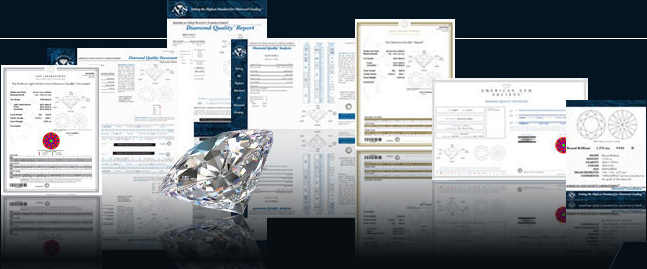
What is a Certificate?
A diamond certificate, also called a diamond grading report, diamond dossier?, or diamond quality document, is a report created by a team of gemologists. The diamond is evaluated, measured, and scrutinized using trained eyes, a jeweler?s loupe, a microscope, and other industry tools. A completed certificate includes an analysis of the diamond dimensions, clarity, color, polish, symmetry, and other characteristics. Many round diamonds will also include a cut grade on the report.
View Certificates While Shopping:
If you are interested in a specific certified diamond at Melisende Diamonds, you can view its certificate on our site before purchase. We offer a variety of grading reports and documentation: GIA Diamond Grading Report GIA Diamond Dossier, AGSL Diamond Quality Document GCAL Certificate of Diamond Authenticity. If you are interested in a diamond and a certificate is not available for viewing on the site, simply contact a diamond and jewelry consultant at info@melisendediamonds.com
| GIA | AGSLAB |
|---|---|
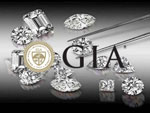 |  |
LOGIN TO OUR DIAMONDS INVENTORY |  LIFETIME WARRANTY | REGISTER FOR ONLINE INVENTORY |

